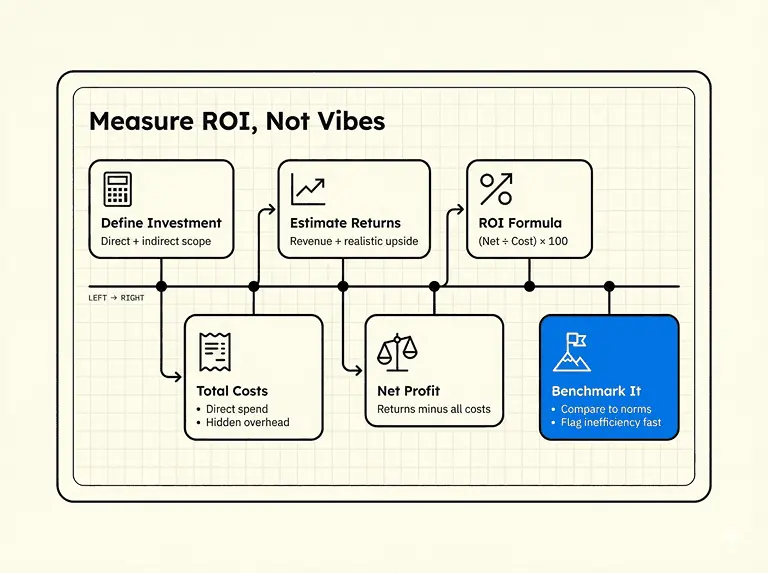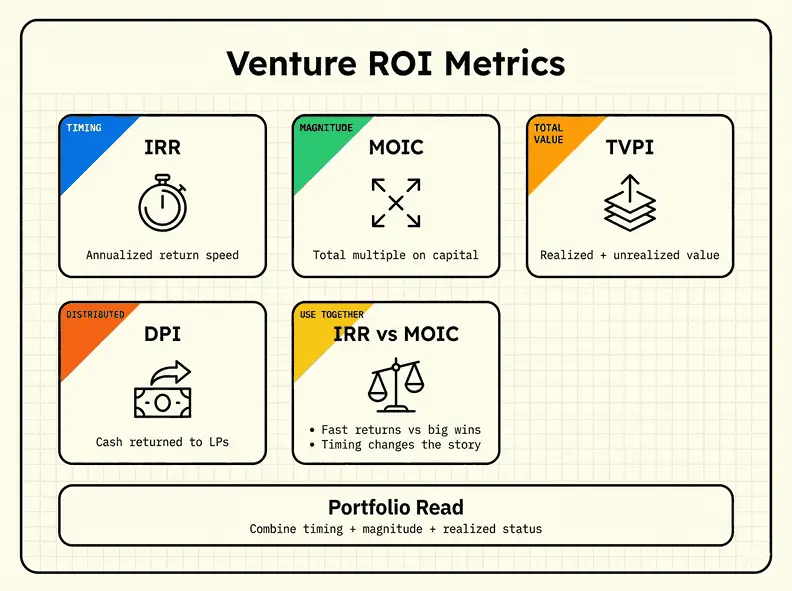ROI measurement is survival math for startups. Cash flow can swing month to month, and funding timelines can stretch far longer than planned. Median gap from seed to Series A was 774 days in Q4 2024, about 2.1 years.
That is why outreach needs tracking, not vibes. Whether you are pitching investors, selling to clients, or building partnerships, the right metrics show what is moving deals forward. Running out of cash as the top reason startups fail, which makes wasted outreach painfully expensive.
Inside, you will find the startup outreach metrics that matter, plus the tools and dashboards to monitor them cleanly. It is built for founders and venture investors who want practical ROI measurement and stronger portfolio decisions.
Fundamental ROI Measurement: Calculating and Analyzing Startup Investments
Understanding how to measure Return on Investment (ROI) is a cornerstone of evaluating startup success. For startups, where cash flows are often unpredictable and funding cycles vary, ROI measurement requires a tailored approach. This section outlines a step-by-step process to calculate ROI, ensuring both direct and indirect costs are accounted for, and highlights the importance of benchmarking performance against industry standards

1. Define the Investment
The first step in ROI measurement is to clearly define the scope of your investment. For startups, this could include seed funding, operational expenses, or marketing campaigns. It’s essential to categorize these investments into direct costs, such as equipment purchases or salaries, and indirect costs, like office utilities or software subscriptions.
2. Tally Direct and Indirect Costs
Accurate ROI measurement hinges on capturing the full spectrum of costs. Direct costs are straightforward, encompassing expenses like product development or marketing campaigns. Indirect costs, however, can be trickier to quantify. These might include shared resources, administrative overheads, or even depreciation of assets.
For instance, if your startup invests in marketing, it’s crucial to include both the cost of ad placements and the time spent by your team managing campaigns. Neglecting indirect costs can lead to an underestimation of your total investment, skewing ROI calculations.
3. Estimate Expected Returns
Once costs are defined, the next step is to project the returns. For startups, this might involve revenue from product sales, customer acquisition, or even intangible benefits like brand recognition. It’s important to set realistic expectations, especially in the early stages when returns may be inconsistent.
To illustrate, marketing ROI benchmarks can vary significantly by channel. Email marketing, for example, can yield $40 for every $1 spent, while SEO generates $22.24, and mobile marketing delivers $10.51. These figures highlight the importance of channel-specific ROI analysis to gauge the effectiveness of your investments.
4. Derive Net Profit
Net profit is the difference between your total returns and total costs. This figure forms the foundation of your ROI calculation. For startups, it’s vital to consider the timing of returns, as irregular cash flows can impact the accuracy of your analysis.
5. Calculate ROI
The formula for ROI is straightforward:
ROI = (Net Profit / Investment Cost) x 100
For example, if your startup invests $50,000 and generates a net profit of $75,000, the ROI would be:
ROI = ($75,000 / $50,000) x 100 = 150%
To gain a clearer picture over time, especially for multi-year investments, consider calculating annualized ROI. This approach accounts for the duration of the investment, providing a more accurate measure of performance.
Why Use Annualized ROI for Fair Comparisons
Building on the basic ROI calculation, annualized ROI adjusts returns for the length of the investment period. This approach enables fair comparisons between investments held for different durations. Without annualization, a short-term gain may appear less impressive than a long-term return, even if the rate of growth is higher. Using annualized ROI ensures that performance assessments reflect the true pace of value creation.
6. Benchmark Performance
Finally, compare your ROI against industry benchmarks to evaluate its effectiveness. Benchmarking performance against industry standards can make all the difference. A general annual ROI range of 7-10% is considered healthy, though startups often aim higher to justify the risks involved.
Recent data clarifies capital efficiency standards. For Series A SaaS startups, the median burn multiple is 1.6×. This means spending $1.60 for every dollar of new ARR generated, framing realistic ROI expectations. Startups can use this as a benchmark for prudent allocation.
By following these steps, startups can develop a robust framework for ROI measurement, ensuring informed decision-making and sustainable growth.
Evaluating Industry Benchmarks and Performance Standards
Understanding industry benchmarks is essential for assessing the performance of startups within a broader context. A good ROI for a startup is considered to be between 7 and 10% annually. This figure serves as a general benchmark, offering a baseline for evaluating whether a startup is meeting, exceeding, or falling short of typical expectations. However, these benchmarks are not universal; they are influenced by several factors, including geographic location, the maturity of the startup, and prevailing market conditions.
The Role of Geographic and Sector-Specific Factors
ROI benchmarks can vary significantly depending on the region and industry in which a startup operates. For instance, startups in tech hubs like Silicon Valley may face higher performance expectations due to the competitive environment and access to capital. Conversely, startups in emerging markets might operate under different standards, where a lower ROI could still be considered successful due to differing economic conditions. Sector-specific factors also play a role; industries such as fintech or biotech often have longer development cycles, which can impact ROI timelines and expectations.
Startup Maturity and Market Conditions
The stage of a startup’s lifecycle is another critical determinant of ROI. Early-stage startups often prioritize growth over profitability, which can result in lower short-term returns. On the other hand, more mature startups are typically expected to deliver consistent ROI as they stabilize their operations and scale. Market conditions, such as economic downturns or industry disruptions, can further influence these benchmarks. For example, during periods of economic uncertainty, even established startups may experience fluctuations in ROI.
Why Benchmarks Matter for Portfolio Management
For investors and portfolio managers, understanding these benchmarks is crucial. They provide a framework for evaluating individual startup performance within the context of broader industry standards. This helps in making informed decisions about resource allocation, risk assessment, and long-term strategy. By comparing a startup’s ROI to these benchmarks, investors can identify areas of strength and opportunities for improvement.
In conclusion, while the 7-10% annual ROI benchmark offers a useful starting point, it’s important to consider the nuances introduced by geographic, sector-specific, and lifecycle factors. These insights not only help contextualize individual performance but also support more effective portfolio management strategies.
When considering function-specific benchmarks, B2B marketing delivers strong performance. In 2024, average B2B marketing ROI reached 5:1. For every dollar spent, companies earned $5, which reflects the sector's effectiveness compared to broader benchmarks. This allows marketers to set realistic expectations within portfolio strategy.
Advanced Venture Metrics: From IRR to MOIC
Advanced metrics like IRR, MOIC, TVPI, and DPI give deeper insight into timing and scalability. These go beyond traditional ROI calculations.
IRR (Internal Rate of Return) measures yearly investment growth rate; MOIC (Multiple on Invested Capital) shows total value returned compared to capital invested; TVPI measures total value (realized/unrealized) to paid-in capital; DPI indicates distributed value relative to capital.

1. IRR: The Timing of Returns
IRR measures the annualized rate of return on an investment, factoring in the timing of cash flows. Unlike simple ROI, IRR accounts for when returns are realized, making it particularly useful for evaluating investments with uneven cash flows. For venture capitalists, IRR highlights the speed at which capital is returned, a critical consideration in fast-moving markets.
2. MOIC: The Magnitude of Gains
MOIC, on the other hand, focuses on the total value generated relative to the initial investment. This metric is a straightforward ratio that compares the exit value to the invested capital. While it doesn’t account for the time value of money, MOIC is invaluable for assessing the overall magnitude of returns, especially in long-term investments.
3. Balancing IRR and MOIC
Comparing IRR with MOIC allows investors to strike a balance between the speed of returns and the scale of gains. For instance, a high IRR might indicate quick returns, but if the MOIC is low, the overall value created might be limited. Conversely, a high MOIC with a low IRR could signal substantial value creation over a longer period. Together, these metrics help investors align their strategies with their financial goals.
4. TVPI and DPI: Tracking Value Creation
TVPI and DPI are additional metrics that provide clarity on the performance of venture funds. TVPI measures the total value created (both realized and unrealized) relative to the capital invested. DPI, in contrast, focuses solely on realized returns, showing how much capital has been distributed back to investors. These metrics are particularly useful for tracking the progress of a fund over time and assessing its ability to deliver on its promises.
Advanced ROI metrics like IRR, MOIC, TVPI, and DPI empower investors with a comprehensive toolkit for evaluating startup performance. By considering both the timing and magnitude of returns, these metrics offer a holistic perspective that goes beyond traditional ROI calculations.
How To Use Influences ROI Outcomes
These advanced metrics gain further complexity when leverage is involved, as borrowed capital can amplify both returns and risks. Leveraged investments may show higher ROI percentages, but losses are also magnified if performance declines. Understanding this dynamic is essential for accurately assessing risk-adjusted returns in startup portfolios.
Addressing ROI Pitfalls: Key Challenges and Solutions
ROI measurement can be deceptively straightforward, yet it often conceals complexities that can mislead investors. A closer look reveals several common pitfalls that, if left unaddressed, can distort the true picture of an investment's performance.
1. Overlooking Risk Adjustments
Traditional ROI calculations frequently fail to account for risk, leading to inflated performance figures. For instance, two investments with identical ROI percentages may carry vastly different levels of risk. Ignoring this factor can result in overestimating the value of high-risk ventures. A more accurate approach involves adjusting ROI to reflect the probability of achieving projected returns, ensuring a balanced evaluation.
2. Excluding Indirect Costs
Another common oversight is the exclusion of indirect costs, which can significantly distort ROI outcomes. While direct costs like initial investment are easy to quantify, indirect costs—such as operational expenses, opportunity costs, or even compliance fees, often go unnoticed. These hidden expenses can erode profitability, making it essential to include them in ROI calculations for a more realistic assessment.
3. Neglecting Intangible Benefits
ROI calculations that focus solely on tangible metrics risk undervaluing investments with significant intangible benefits. For example, a project that enhances brand reputation or customer loyalty may not yield immediate financial returns but can create long-term value. A comprehensive ROI analysis should incorporate both tangible and intangible factors to capture the full spectrum of an investment's impact.
A Broader Perspective
Investors who adopt a holistic approach to ROI measurement can avoid these pitfalls and make more informed decisions. Diversifying investment approaches involves recognizing the nuances of market liquidity, a subject explored in secondary share sales investors to illustrate potential strategies for handling secondary market transactions.
By addressing these challenges, investors can achieve a more accurate and nuanced understanding of ROI, paving the way for smarter, more sustainable investment strategies.
Innovative Approaches: Managing ROI in Innovation
Maximizing Innovation ROI requires a nuanced understanding of how to measure and manage returns in a rapidly evolving landscape. Organizations that succeed in this endeavor often adopt innovative frameworks, balancing exploratory initiatives with the exploitation of existing assets. This section delves into the critical components of managing ROI in innovation, including the categorization of innovation types, the role of accelerators, and strategies for achieving exponential returns.
Effective innovation ROI frameworks can radically scale operations. Nubank applied strategic innovation to grow from 93.9 million users in 2023 to 114.3 million in 2024. They maintained an operating cost per customer of only $0.80. This underscores how advanced investment models foster rapid growth while preserving cost efficiency.
1. Balancing Exploration and Exploitation
Striking the right balance between exploration and exploitation is a hallmark of ambidextrous organizations. Exploration focuses on discovering new opportunities, while exploitation optimizes existing assets. Both are essential, but their ROI metrics differ significantly. Exploratory initiatives often require long-term investment with uncertain outcomes, making traditional ROI metrics less effective. Instead, organizations can use innovation-specific KPIs, such as the number of prototypes developed or customer feedback loops, to measure progress.
On the other hand, exploitation initiatives benefit from more conventional ROI metrics, such as revenue growth or cost savings. By aligning the measurement framework with the type of innovation, organizations can ensure that both exploration and exploitation contribute meaningfully to their overall ROI.
2. Tailoring ROI Frameworks to Innovation Types
Not all innovations are created equal, and neither are their returns. Innovations can be categorized into three primary types:
- Incremental Innovation: Focuses on improving existing products or processes. ROI measurement here is straightforward, often tied to efficiency gains or market share growth.
- Disruptive Innovation: Introduces entirely new business models or technologies. ROI metrics for disruptive innovation should account for market creation and long-term scalability.
- Radical Innovation: Pushes the boundaries of what’s possible, often requiring significant investment with high risk. Metrics like intellectual property generation or strategic positioning are more relevant for radical innovation.
By tailoring ROI frameworks to these categories, businesses can better allocate resources and set realistic expectations for returns.
3. Setting Up an Innovation Accelerator
An innovation accelerator can serve as a catalyst for achieving exponential ROI. These programs provide a structured environment for developing and scaling innovative ideas. Key components of a successful accelerator include:
- Systematic Funding: Allocating resources in metered stages ensures that only the most promising ideas receive continued investment.
- Cross-Functional Teams: Bringing together diverse expertise fosters creativity and problem-solving.
- User-Centric Design: Prioritizing customer needs ensures that innovations are both relevant and impactful.
The success of accelerators like BioCity underscores the potential of this approach. Highlighting the BioCity success story, we see how focusing on customer needs drives better ROI in healthcare innovation. By aligning their efforts with user-centric design principles, BioCity achieved significant returns while addressing critical challenges in the healthcare sector.
4. Strategies for Achieving 10x ROI
Achieving a tenfold return on investment in innovation is ambitious but attainable with the right strategies:
- Adopt Agile Methodologies: Rapid prototyping and iterative development reduce time-to-market and improve product-market fit.
- Invest in Scalable Technologies: Prioritize innovations that can scale quickly, such as digital platforms or AI-driven solutions.
- Foster a Culture of Experimentation: Encourage teams to test bold ideas without fear of failure, as this often leads to breakthrough innovations.
- use Data Analytics: Use data-driven insights to refine strategies and identify high-potential opportunities.
By implementing these strategies, organizations can position themselves to achieve exponential returns while mitigating risks.
Managing ROI in innovation is as much an art as it is a science. By balancing exploration with exploitation, tailoring measurement frameworks, and leveraging accelerators, businesses can unlock the full potential of their innovation efforts.
Real-World ROI: Performance and Practical Applications in Startups
Measuring ROI in startups is not a one-size-fits-all process. Each stage of a startup’s journey, from seed funding to scaling, demands tailored ROI benchmarks that align with its unique challenges and opportunities. Understanding how to adapt ROI methodologies to these stages can provide startups and investors with actionable insights to optimize performance and maximize returns.
1. ROI Targets Across Startup Stages
Startups evolve through distinct phases, and ROI expectations must shift accordingly. During the seed stage, ROI is often measured in terms of market validation and early traction. Metrics like customer acquisition cost (CAC) and lifetime value (LTV) are critical indicators of whether the business model holds promise. As the startup progresses to the growth stage, ROI measurement becomes more complex, focusing on scalability, operational efficiency, and profitability.
For instance, a seed-stage startup might prioritize ROI metrics tied to user engagement or product-market fit, while a growth-stage company would emphasize revenue growth and market share. Adjusting these targets ensures that ROI assessments remain relevant and actionable, regardless of the startup’s maturity.
2. Scenario Analysis and Sensitivity Testing
Strategic decisions can significantly impact ROI outcomes, and scenario analysis is a powerful tool for anticipating these effects. By modeling different scenarios—such as changes in pricing strategies, marketing spend, or operational costs, startups can evaluate how each decision influences their ROI.
Sensitivity testing complements this approach by identifying which variables have the greatest impact on ROI. For example, a startup might discover that a 10% increase in customer retention yields a higher ROI than a similar increase in ad spend. These insights enable founders to allocate resources more effectively and make data-driven adjustments to their strategies.
Practical Applications for Investors
For investors, understanding a startup’s ROI performance is essential for refining portfolio strategies. Practical ROI methodologies, such as scenario analysis, can help investors assess the potential of their existing investments and identify opportunities for improvement. Evaluating growth alongside risk reduction can be enriched by startup portfolio management tips, offering a balanced view on scaling strategies and effective risk control.
Moreover, ROI insights can guide investors in determining when to double down on high-performing startups or pivot away from underperforming ones. This dynamic approach ensures that investment decisions are grounded in real-world performance data, rather than static projections.
Strategic Adjustments for Maximizing ROI
Startups that actively monitor and adjust their strategies based on ROI data are better positioned to succeed. For example, a SaaS startup might use ROI analysis to identify underperforming customer segments and reallocate resources to more profitable ones. Similarly, an e-commerce business could experiment with different pricing models to optimize revenue without sacrificing customer satisfaction.
By integrating ROI measurement into their decision-making processes, startups can create a feedback loop that drives continuous improvement. This proactive approach not only enhances financial performance but also builds investor confidence, paving the way for sustained growth.
ROI is not just a metric; it’s a strategic tool that can shape the trajectory of a startup. By aligning ROI targets with each stage of growth, leveraging scenario analysis, and applying insights to real-world decisions, startups and investors can unlock new opportunities for success.
Best Practices and Trends: Using Innovative Technologies for ROI
The methods for measuring ROI are undergoing a significant transformation, driven by advancements in technology and shifting market priorities. Emerging trends such as AI-driven analytics, blockchain-based tracking, and ESG (Environmental, Social, and Governance) integration are redefining how organizations evaluate performance and align their investments with modern values.
1. AI and Blockchain: Real-Time Insights and Transparency
AI-powered analytics and blockchain technology are revolutionizing ROI measurement by enabling real-time data analysis and fostering unparalleled transparency. Organizations now utilize AI to generate predictive insights, allowing them to anticipate performance outcomes and adjust strategies proactively. Blockchain, on the other hand, ensures secure and immutable tracking of financial transactions, making ROI calculations more reliable and transparent. Together, these technologies enhance risk analysis and provide continuous performance tracking, empowering businesses to make data-driven decisions with confidence.
2. ESG Integration: Aligning ROI with Investor Priorities
Incorporating ESG factors into ROI frameworks is no longer optional, it’s essential. Investors increasingly prioritize sustainability and ethical considerations, making ESG integration a critical component of modern performance evaluation. By embedding ESG metrics into ROI calculations, organizations can align their strategies with investor values while addressing long-term risks and opportunities. This approach not only meets market demands but also strengthens stakeholder trust.
3. Enhancing Risk Analysis with Technological Advancements
The adoption of innovative technologies like AI and blockchain doesn’t just improve ROI measurement—it also refines risk analysis. These tools provide a deeper understanding of potential vulnerabilities, enabling businesses to mitigate risks before they escalate. For instance, AI-driven analytics can identify patterns and anomalies in data, while blockchain ensures the integrity of financial records. This dual approach fosters greater accountability and transparency, which are vital for building investor confidence.
A broader understanding of investor engagement is enhanced when you consider how to improve startup outreach strategy, connecting outreach efforts with the overarching aim of portfolio expansion.
Future Outlook: Strategic Recommendations for Sustainable ROI
The evolving landscape of ROI measurement is set to transform how investors approach long-term returns. Automation and integrated ESG (Environmental, Social, and Governance) data are becoming indispensable tools for calculating sustainable ROI. These advancements not only streamline processes but also provide deeper insights into portfolio performance, ensuring decisions align with both financial and ethical goals.
1. Automation and ESG Integration
As technology continues to advance, automated tools are reshaping ROI calculations. These systems can process vast amounts of data, offering real-time insights into investment performance. By integrating ESG metrics, investors can assess how their portfolios align with sustainability goals, creating opportunities for ethical growth. For instance, automated platforms can evaluate carbon footprints or social impact alongside traditional financial metrics, ensuring a holistic view of returns.
2. AI-Driven Risk Assessments
Artificial intelligence is revolutionizing risk management, particularly for startup portfolios. AI-driven models can analyze historical data, market trends, and potential disruptions to predict risks with remarkable accuracy. This capability is crucial for identifying vulnerabilities in early-stage investments and optimizing strategies for long-term growth. Reviewing the timing of investment exits is informed by startup exit strategies for investors, which presents a straightforward discussion on optimizing portfolio adjustments and cash-out opportunities.
3. Achieving Portfolio Synergy
To maximize sustainable ROI, investors must focus on portfolio synergy—ensuring that individual assets complement each other to drive collective growth. This involves aligning investments with overarching themes, such as renewable energy or tech innovation, to create a cohesive strategy. By fostering synergy, portfolios can achieve resilience and adaptability, even in volatile markets.
Strategic Recommendations
- Adopt Automated Tools: Utilize platforms that integrate ESG data for comprehensive ROI analysis.
- Leverage AI for Risk Management: Incorporate AI-driven assessments to identify and mitigate risks in startup portfolios.
- Focus on Synergy: Align investments with thematic goals to enhance long-term returns and sustainability.
By embracing these strategies, investors can position themselves for success in an increasingly data-driven and sustainability-focused investment landscape.
Conclusion
Achieving optimal Startup ROI requires more than traditional metrics; it demands a comprehensive approach that blends data-driven insights with advanced portfolio management strategies. Throughout this blog, we’ve explored the importance of evaluating startups holistically, combining financial performance with qualitative factors like market positioning and scalability. By integrating these strategies, investors can make more informed decisions and maximize returns across their portfolios.
At Qubit Capital, we specialize in aligning startups with the right investors through tailored services like Investor Discovery and Mapping. If you're ready to elevate your portfolio management and connect with optimal investors, we invite you to explore how our expertise can support your goals.
Key takeaways
- Accurate ROI measurement is critical for evaluating startup investments.
- Inclusive cost analysis, covering both direct and indirect expenses, is essential.
- Advanced metrics such as IRR, MOIC, TVPI, and DPI provide deeper insights into performance.
- Innovation ROI requires balancing exploratory initiatives with the exploitation of existing assets.
- Adopting best practices and emerging technologies drives sustainable portfolio management.
Frequently asked Questions
What is ROI in startup investments?
ROI in startup investments measures the efficiency of an investment. It compares the net profit generated to the total investment cost. Accurate ROI evaluation supports investors in optimizing their portfolios.






